The CSS Solved General Science & Ability (GSA) Past Paper 2015 is Solved by Pakistan’s top GSA Coaches, Miss Iqra Ali. They are the only coaches available in Pakistan who have solved the last 20 years GSA solved papers to help aspirants know how to attempt the paper to score above 80. And they have guided thousands of CSS and PMS aspirants. Both coaches have been known for their teaching methodology and imparting concepts to their students, who scored the highest marks in this subject. At the special request of CSSPrepForum, both coaches have solved the paper.

PART-II
Question No. 2
A- Iibn-e Batoota’s famous book Rihalah is an important source of history and geography. Justify it.
B- Albarouni is recognized more as natural scientist rather theorist. Comment.
Question breakdown
In this question, the examiner has asked you to explain Ibn e Batoota’s famous book with its relevance to history and geography in the first part and a note on Albarouni, justifying him as a scientist than a theorist. However, the header of “Muslim Scientists” has now been omitted from the General Science and Ability Syllabus by FPSC from the year 2016 onwards. Hence, the question is considered outdated, and there is no need to prepare it; therefore, not solved in the paper.
Question No. 3
A- How solar eclipse and lunar eclipse are caused?
Question Breakdown:
In this question, the examiner has asked you to explain the phenomenon of the formation of the solar eclipse and lunar eclipse. Thus, start your answer by defining Eclipse in your own words and then move towards the formation of both one by one. At the end of each, draw a schematic diagram explaining the whole phenomenon in an image.
Answer:
Define Eclipse:
The eclipse means the obscuring of one astronomical object by another.
The Formation of Solar Eclipse:
A lunar eclipse means obscuring the Earth from the Sun’s light by the Moon’s interaction between the Sun and the Earth. In other words, a solar eclipse happens when the moon passes in between the Earth and the sun, partially or fully hiding the sun’s rays for a few minutes. It usually occurs once in eighteen months in the daytime.
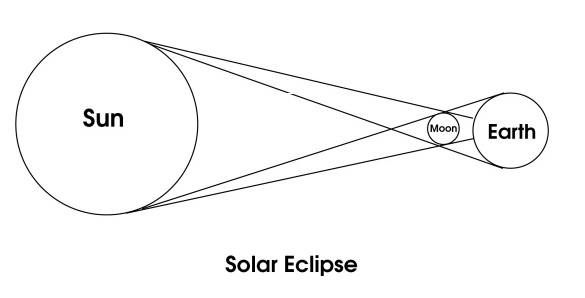
The Formation of Lunar Eclipse:
A lunar eclipse means obscuring the moon from the Sun’s light by the Earth’s interaction between the Sun and the moon. In other words, when Earth comes between the Sun and the Moon and partially or fully casts a shadow across the lunar surface, this situation is called a lunar eclipse. It’s a common phenomenon, and about three lunar eclipses occur yearly.

[The same question was asked in GSA paper 2017, Question No. 4 (b), where the examiner has asked it differently; thus, you are supposed to attempt that question differently.]
B- Discuss the function of kidneys in human body.
Question Breakdown:
In this question, the examiner has asked you to explain the functioning of kidneys in the body. However, before directly jumping to the functioning, explain the structure, location, size, and shape of the kidney in two to three lines to create coherence in the question. After done, describe a minimum of four to five functions with a neat relevant diagram. Remember, writing too much cannot help you gain maximum marks, but the relevancy and presentation do.
Answer:
Definition of Kidneys:
The kidneys are a pair of bean-shaped organs situated in the upper abdominal cavity, one on each side of the spine, below the ribs and behind the belly. Each kidney is approximately 3 cm thick, 6 cm wide, and 12 cm long, roughly the size of a large fist, with a reddish-brown colour. Functional units of the kidney are called nephrons, which are millions in number per kidney and responsible for carrying out the primary functions of the kidneys.
Functions of Kidneys:
The kidneys are vital organs in the human body, playing a crucial role in maintaining overall health and homeostasis. They manage fluid levels, electrolyte balance, and other factors that keep the internal environment of the body consistent and comfortable. Some other functions are given below:
- Filtration of Blood:
The primary function of the kidneys is to filter blood to remove waste products and excess substances from the body. Filtration specifically takes place in the Glomerulus– a network of capillaries in the nephrons of the kidney- because of the filtration pressure and porous surface of the glomerulus. The waste products and excess ions are separated from the blood, and there remains a filtrate called Glomerular Filtrate.
- Re-absorption of Water and Nutrients:
All the useful substances in the glomerular filtrate, glucose, amino acids, bicarbonates, and phosphates, are reabsorbed in the proximal convoluted tubules, leaving the filtrate with most of the nitrogenous wastes. Moving down the limbs of loops of Henle, the kidneys reabsorb excessive water and ions through the process called Counter Current Multiplier.
- Excretion of Waste Products:
Filtering waste products from the blood, the kidneys excrete various metabolic waste products- such as urea, creatinine, uric acid, and drug metabolites- that are produced from the breakdown of proteins and other cellular processes.
- Maintaining pH and Electrolyte Balance:
The kidneys help maintain the body’s pH in the optimal range, that is, 7.35-7.45, by excreting hydrogen ions and reabsorbing bicarbonate ions. This process is crucial to prevent excessive acidosis or alkalosis in the body, which can be fatal. Moreover, kidneys maintain the balance of electrolytes, such as sodium, potassium, calcium, and chloride, in the body, by increasing or decreasing urine concentration in response to Aldosterone and Antidiuretic Hormone, ensuring that the internal environment remains within a narrow functional range.
- Secretion of active compounds:
The tubular epithelium of the nephron also secretes substances, including Erythropoietin, controlling the production of red blood cells; Renin, managing the volumes of blood plasma, lymph, and interstitial fluid; and Calcitriol, increasing the amount of calcium the intestines can absorb and the reabsorption of phosphate in the kidneys.
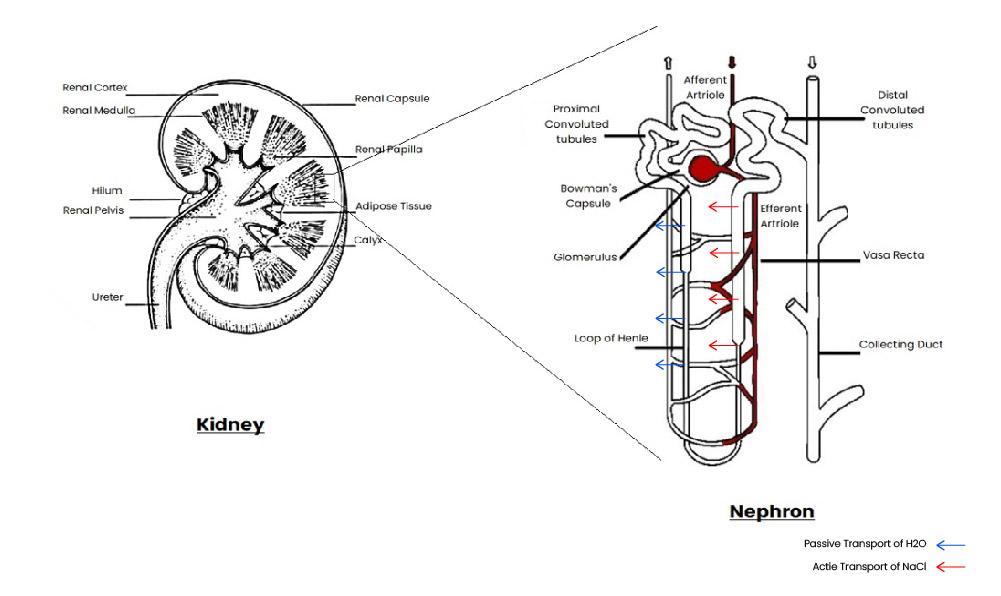
[The same question has been asked in GSA paper 2023, Question No. 3 (b) with special reference to the role of the kidney in excretion. There, you are supposed to answer it differently.]

Question No. 4
A- Describe briefly the principle working of two of the followings
(i) Television
(ii) Microwave oven
(iii) RADAR
Question Breakdown
In this particular question, there are two parts which you are supposed to answer. For your ease, all three parts are solved here. To deal with it, first divide the marks weightage, according to which each is 2.5 marks. So, just writing a basic definition of the instrument and a brief principle working mechanism in three to four lines is more than enough to meet the requirement. Moreover, you can draw block diagrams if any.
Answer:
- (I) Television:
Television is an electronic device that receives broadcasted audio and visual signals.
Working of Television:
Television works on the Principle of “Electromagnetic Wave Propagation and Reception” broadly. First, Images and sound with cameras and microphones are encoded into electronic signals; the electrical signals are further processed and encoded into digital data using Analog-to-Digital Converters (ADCs) for improved transmission quality and compatibility and transmission. Then, the encoded signals are sent to the receiver via a transmitter. The receiver equipped with tuners and demodulators decodes the signals, which are then displayed on a screen using light-emitting diodes (LEDs), liquid crystal displays (LCDs), or other technologies, while the sound is reproduced through built-in or external speakers.
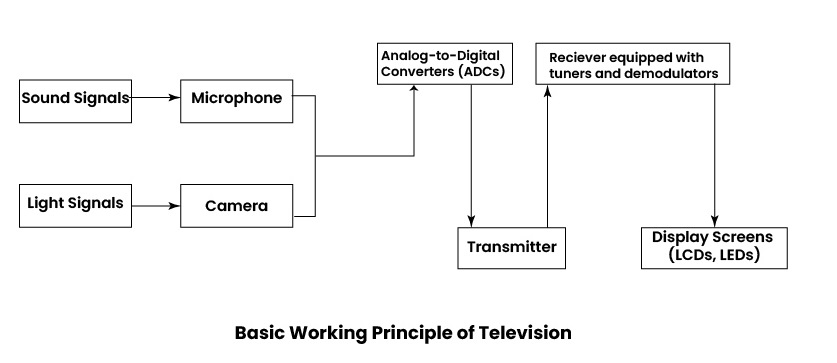
- (II) Microwave Oven
The micro oven is a simple device operating at a very high frequency and is used for heating and cooking purposes.
Working of Microwave Oven:
The working principle of a microwave oven involves the generation and utilization of microwave radiation. Microwave works on the principle of conversion of electromagnetic energy into thermal energy. The oven generates microwave radiation – a very high energy electromagnetic radiation with a frequency ranging between 300 MHz and 300 GHz and wavelength from 1 mm to around 30 cm approximately when switched on. When a polar molecule (like water) present in the food falls in the path of these EM radiations, it oscillates to align with them, changing the electric field of the microwaves. It, as a result, leads to their rapid oscillation and the conversion of electromagnetic energy into thermal energy, which heats the food. Frequency and wavelength allow microwaves to penetrate deep inside the food and cook it from inside while the temperature of the air present around the food remains constant as air is non-polar.
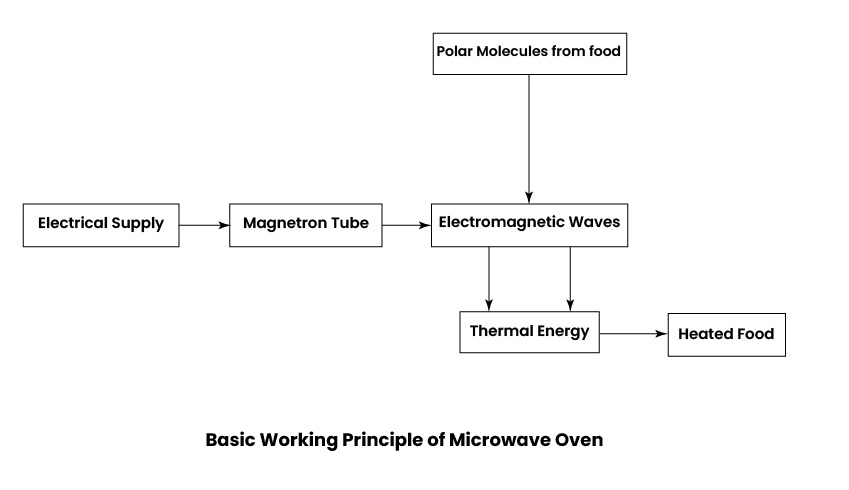
- (III) RADAR
RADAR is Radio Detection and Ranging. It is a technology used for detecting and tracking objects by transmitting radio waves and analyzing their reflections to identify obstacles to control the area of the spot or range of an object. It is used in various applications, including aviation for aircraft navigation and collision avoidance, meteorology for weather tracking, maritime navigation, military surveillance, and traffic control.
Working of RADAR:
The principle behind the working of RADAR is “The Doppler Effect”- the change in frequency or wavelength of waves (such as sound, light, or radio waves) in relation to an observer moving relative to the source of the waves. The RADAR system emits electromagnetic radio waves, which spread through space at the speed of light. When these waves encounter an object, they reflect back as echoes. A receiver receives these echoes, carrying information about distance, direction, and object traits. Precise time measurement of wave travel yields distance, and signal processing determines time delay and frequency shift, indicating object speed.

B- What is current status and future perspective of BIOTECHNOLGY in Pakistan?
Question Breakdown:
In this question, the examiner has asked you to analyze the current situation of Biotechnology, along with its future prospects, with special reference to Pakistan. Thus, start your question with the basic definition of Biotechnology and give a few examples. Then, jump to the main part, i.e., the current situation. It is better to add references of some authentic figures in the field or the stats from any think tanks. When done, write down a future pathway- including suggestions- in 4 to 5 lines. Remember, it is just a five marks question, and the paper you are solving solely belongs to science. So, keep these points in special consideration while attempting the answer.
Answer
Define Biotechnology:
Biotechnology is a field of science and technology that involves the application of biological systems, organisms, or living cells to develop or create products, processes, or technologies that benefit various sectors, such as agriculture, healthcare, the environment, and industry. It encompasses a wide range of techniques, including genetic engineering, molecular biology, biochemistry, and microbiology, among others.
Example of Biotechnology:
Genetic Engineering, DNA Sequencing, Synthetic Biotechnology, Bioremediation, etc
The Current Status of Biotechnology in Pakistan:
With the significant emergence of modern biotechnology around the world, Pakistan, in the early 1980s, started recognizing the importance of this field by expressing interest in hosting the International Centre for Genetic Engineering and Biotechnology (ICGEB) proposed by UNIDO. To further its development, a National Commission on Biotechnology and a National Policy and Action Plan were formulated as part of the Mid-Term Development Framework, with substantial investments totalling over Rs. 5.0 billion (approximately USD 40 million) during the past decade. Since then, the country has experienced significant growth and development, with a focus on agriculture, healthcare, and industrial biotechnology. Presently, around 500 researchers are engaged in biotechnology studies across 30 biotech centres in the country. Moreover, the country has been in the top ten countries of GM crop producers during the last few years. Biotechnology has also been utilized in healthcare for pharmaceuticals, vaccines, and diagnostics. Pakistani biotech companies are involved in manufacturing biologics, biosimilars, and enzymes.
Future Prospects of Biotechnology:
The future of biotechnology in Pakistan is promising. Biotechnology is being applied in agriculture for crop improvement and addressing food security challenges. In healthcare, there are opportunities for biopharmaceutical production and personalized medicine. Industrial biotechnology holds potential for biofuels and environmentally friendly processes. The country has the potential to become a hub for biomanufacturing, producing biopharmaceuticals, enzymes, and other bioproducts for local use and export. However, the success will depend on factors such as policy support, funding availability, infrastructure development, and collaboration between academia, industry, and government. Further, continued investment in research and development is crucial for biotech growth, thus, fostering innovation and bringing new solutions to the various sectors.

Question No. 5
A- What do you mean by night vision technology?
Question Breakdown:
In this question, the examiner has again left it to you to explain night vision technology per your understanding. So you can split the headings per your ease. However, all the information must be valid, to the point, and relevant. Remember, avoid writing extras in it; stick to what exactly has been asked. At last, draw a diagram/ table/block, etc., if any.
Answer:
Night Vision Technology:
The technology which allows humans to see in environmental conditions with little or no light by using night vision devices is called night vision technology.
Working Principle of Night Vision Technology:
Night vision technology works on the principle of converting infrared light into visible light through a channel of photocathode and phosphor because infrared light, having a wavelength longer than visible light, cannot be detected by the naked human eye.
Working takes place in the following steps
- Infrared light from a dark environment strikes the front lens of the night vision device.
- The energy packets of infrared light then strike the photocathode, which converts visible light energy into electrons
- The electrons undergo excitation, and then de excites to lower energy electrons which are then captured by the phosphor screen.
- The phosphor screen then converts the electron energy into visible light energy.
- The operator can see the visible light through the eyepiece of the device.
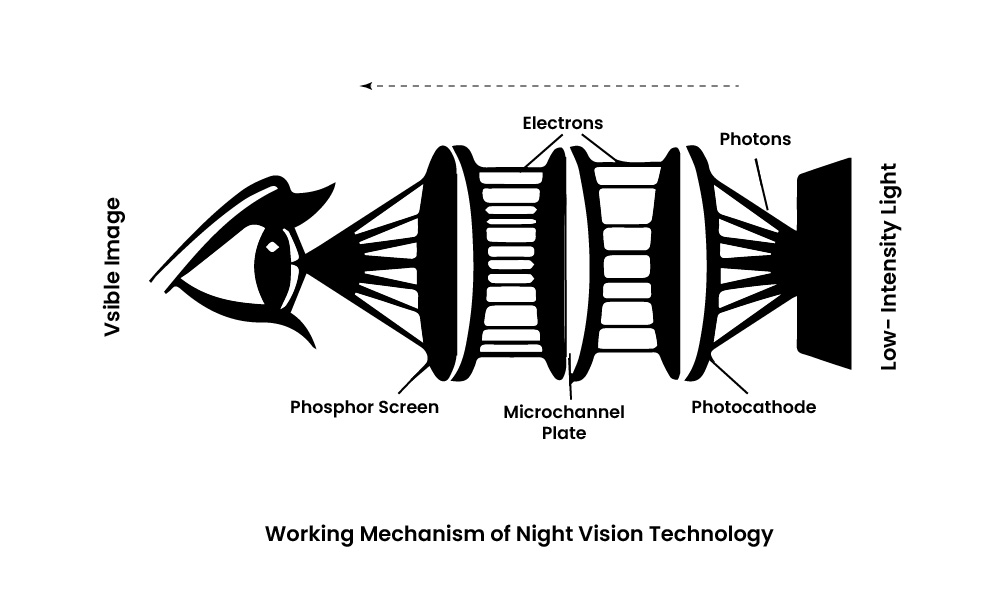
Night Vision Technology Operating Devices:
Under night vision technology, generally, three main types are explained:
- Image Intensifier Night Vision Devices
- Digital Night Vision Devices
- Thermal Imager Devices
Uses of Night Vision Technology:

B- How Energy crises can be minimized in Pakistan.
Question Breakdown:
The examiner has demanded ways to minimize the ongoing energy crisis in Pakistan in this question. Thus, first of all, define Energy Crisis and give an overview of the current situation of the energy crisis in Pakistan. Then, move towards the final part, that is, recommendations and write minimum five practicable ways to deal with the energy issues in the country. Remember, try to answer it more as a natural science question than the social sciences. You can also draw pie chart to elaborate on the current situation. Pay special focus to the presentation while attempting your GSA paper so that you can get exceptional marks in the subject.
Answer:
Define Energy Crisis:
Energy crises refer to situations where there is a shortage or inadequate supply of energy resources- oil, natural gas, electricity, etc., to meet domestic and industrial demand. In simple words, a significant shortfall in the supply or rise of demand for energy is called the energy crisis
An Overview of Energy Crises in Pakistan:
Pakistan is land with ample indigenous natural resources that can play a pivotal role in helping and running the country’s economic vehicle. However, it is witnessing severe energy issues due to the acute energy crisis, mainly caused by the mismanagement of resources.
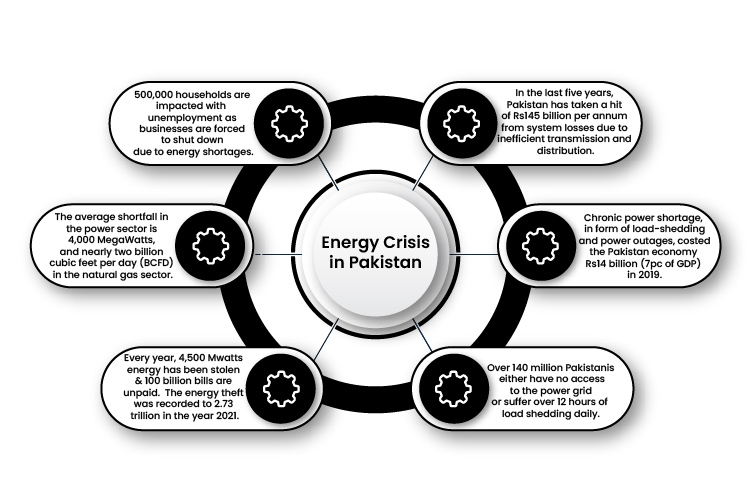
Ways to Minimize Energy Crises in Pakistan:
The following are the ways that can be used to minimize the ongoing energy crisis in the country.
- Switching to Renewable Energy Resources
First, Investing in renewable resources like in solar and wind energy projects to diversify the energy mix. For example, the Quaid-e-Azam Solar Park in Punjab, one of the largest solar projects in the world, is contributing significant clean energy to the national grid
- Buying Energy-Efficient Products
Second, for residential and commercial purposes, traditional bulbs must be replaced with CFLs and LEDs. They use fewer watts of electricity and last longer. So, an energy crisis can be averted. For this purpose, the Punjab Energy Efficiency & Conservation Agency (PEECA) has successfully launched initiatives to improve energy efficiency in various sectors. Nonetheless, steps need to be taken at a broader level.
- Allowing Easier Grid Access
Third, people who use different options to generate power must be given permission to plug into the grid and get credit for the power they feed into it. Apart from that, subsidies on solar panels should be given to encourage more people to explore renewable options.
- Upgrading and Expanding Power Infrastructure
Fourth, Investing in modernizing the power distribution and transmission systems can minimize energy losses. The few dams of the country, for example, need to be revived, and new dams – both big and small- must be constructed to increase energy production through clean sources of energy.
- Performing Energy Audit
Fifth, the energy audit is a process that can help stakeholders identify the areas where homes or offices are losing energy and what steps can be taken to improve energy efficiency.
- Public Awareness and Education
Last but not least, the public must be educated about energy conservation and responsible consumption. For this, the initiatives like the awareness campaign by the “National Energy Conservation Centre” must be taken to promote energy-saving behaviours.

Question No. 6
A- Write short note on Seismography.
Question Breakdown:
In this question, the examiner has asked for a short note on Seismography. Thus, debunk this question at your ease, being relevant and to the point. Generally, for the questions in which a “note” is asked, try starting the answer with the definition, origin-if any, working mechanism, uses, limitation, and types without giving must weightage to the types’ explanation. For instance, in this question, we will write down all the connected definitions: Seismography, seismometer, and seismogram. Then, we will move to the origination and working mechanism, with a schematic diagram in the end.
Answer:
Definition of Seismography:
Seismography is the scientific study and recording of seismic waves generated by earthquakes, volcanic eruptions, explosions, or other sources of ground motion with the help of an instrument called a Seismometer, and the record produced on display is called a Seismogram.
The procedure of Seismography:
Seismometers, or seismographs, are instruments designed to detect ground motion. They consist of a heavy mass, with a marker attached, suspended within a frame. When seismic waves from an earthquake pass through the Earth, they cause the ground to move. The frame of the seismometer moves with the ground, but the suspended mass tends to stay relatively still due to inertia. So, the relative motion between the mass and the frame is recorded on paper through the marker. The recorded motion is transformed into a graphical representation called a seismogram. This graph displays the amplitude of ground motion over time. Advanced seismometers record ground motion in three perpendicular directions: vertical (up-down), north-south, and east-west and are called Three Component Seismometers.
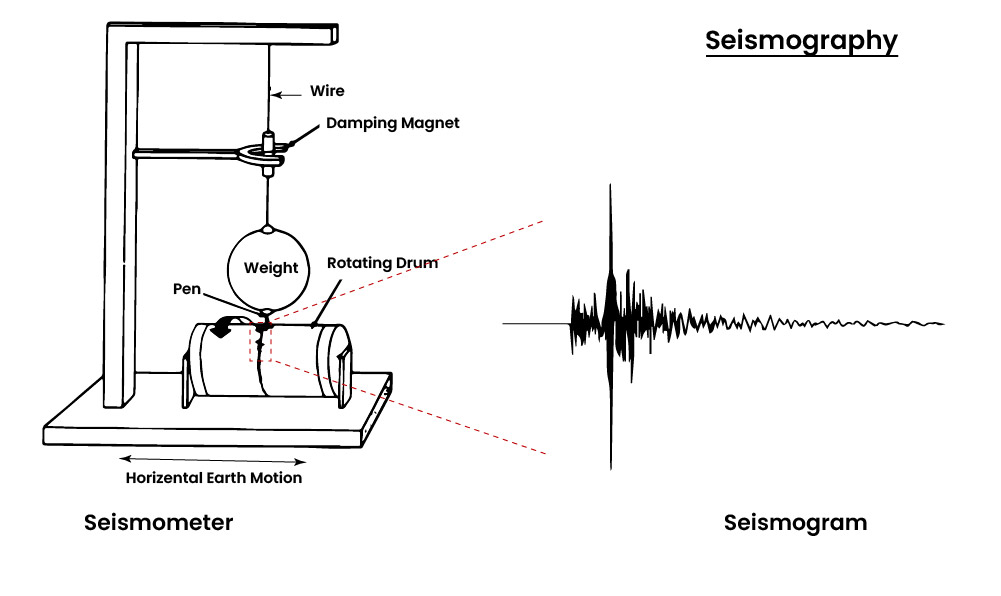
Application of Seismography:
By analyzing seismograms, seismologists can determine the location, depth, magnitude, and other characteristics of earthquakes, contributing to our understanding of the Earth’s interior and seismic activity. Moreover, seismography plays a vital role in earthquake monitoring, hazard assessment, and seismic research.
B- Differentiate between (i) Cell and battery (ii) Smog and Smoke
Question Breakdown:
The question consists of two parts, both dealing with the differences. In the first part, you are supposed to differentiate between Cell and Battery, and the second part requires the difference between Smoke and Smog. There are generally two approaches to dealing with such questions. The first one is to draw two columns, and allot one side to one jargon and write characteristics differences side by side. In the second method, you draw three columns, allotting the leftmost column to the name of the characteristics. The second approach is definitely the best, but choose it only when you are able to draw a neat table, as the presentation and clarity are keys to obtaining maximum marks in GSA Paper
- (I) Cell and Battery
| Characteristic | Cell | Battery |
| Definition | A single electrochemical unit produces electrical energy through chemical reactions. | A collection of two or more cells connected to increase voltage or capacity. |
| Components | Consists of anode, cathode, and electrolyte facilitating ion movement. | Self-contained power source storing and providing energy to a circuit. |
| Size | Typically small and used in low-power devices like watches and calculators. | Larger and capable of storing more energy than individual cells. |
| Usage | Found in wristwatches, calculators, small electronics. | Used in portable electronics, vehicles, backup systems, and grid energy storage. |
| Examples | Button cells, coin cells, alkaline cells. | Rechargeable batteries (e.g., Li-ion) and non-rechargeable batteries (e.g., alkaline). |

- (II) Smoke and Smog
| Characteristic | Smoke | Smog |
| Definition | Airborne particles and gases produced by incomplete combustion or burning. | Air pollution resulting from the mixture of smoke, pollutants, and atmospheric moisture. |
| Associated Areas | Generated from various sources, including wildfires, industry, fossil fuels, and household activities. | Often found in urban and industrial regions with high pollutant levels. |
| Formation Process | Consists of solid particles (e.g., soot, ash) and gases (e.g., CO, CO2) released during combustion. | Forms when pollutants react with sunlight, leading to ground-level ozone and fine particulate matter. |
| Appearance | No specific appearance; depends on the source and conditions. | Has a hazy, fog-like appearance in the atmosphere. |
| Effects | Can have health and environmental impacts depending on composition and exposure. | Detrimental to human health, visibility, and the environment. |
| Composition | Comprises solid particles, gases, and chemicals released during burning. | Includes pollutants like nitrogen oxides, volatile organic compounds, ozone, and fine particles. |

Question No. 7
A- What do you understand by Pollen Allergy.
Question Breakdown:
In this question, the examiner has asked you to explain your understanding of Pollen Allergy. Thus, answer this question at your ease. For instance, you can write the definition of pollen allergy, its types, and the mechanism of how pollen allergy happens. Remember, it will give you a chance to add the diagrammatic presentation to your paper, which will make your paper exceptional. You can also add symptoms and ways to tackle it in bullet form.
Answer:
Define Pollen Allergy:
Pollen Allergy, also known as Hay fever, is an allergy to pollen-a very fine powder produced by trees, flowers, grasses, and weeds. When a person having pollen allergy interacts with pollen, his immune system mistakenly identifies it as a threat and triggers irritation and inflammation.
Types of Pollen Allergy:
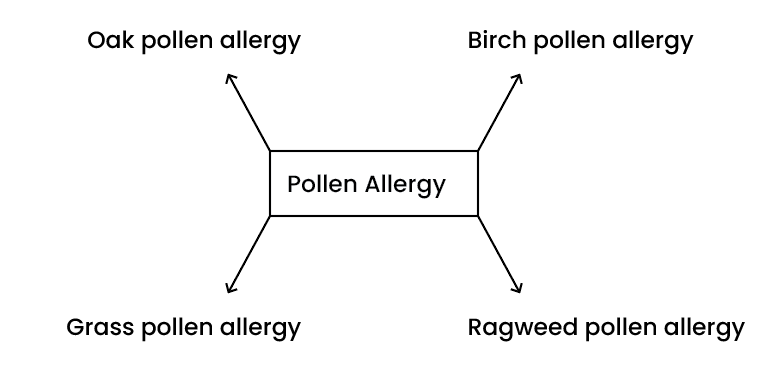
Mechanism of Action of Pollen Allergy:
Allergies happen when external stimulants, like airborne particles-pollen or animal hair, ingest matter-cinnamon or certain medicines. These allergens are perceived as foreign by the immune system, leading it to generate specialized antibodies designed to connect with specific allergen types following the lock and key model. Then, the antigen-antibody conglomerate travels to the mast cells in body tissues, especially surface tissues of the nose and skin. The main job of mast cells is to secrete certain chemicals, like Histamines and Leukotrienes, to flush out the allergens, which as a result, causes an allergic reaction, leading to sneezing, difficulty in breathing, fluid leakage, and a runny nose.

Symptoms of Pollen Allergy:
Symptoms of pollen allergy include
- Frequent and repetitive sneezing
- Persistent cough
- Throat Irritation
- Nasal congestion, itching, and excessive mucus production
- Itchy and teary Eyes
Treatment and Prevention of Pollen Allergy:
Management of pollen allergies typically involves avoiding exposure to pollen, using over-the-counter antihistamines, nasal sprays, and decongestants, and going for Immunotherapy in severe cases.
B- Write down short note on any two of the following. (i) Antibiotics (ii) Hormones (iii) Green House effect?
Question Breakdown:
In this question, the examiner has asked you to write notes on two of three given terminologies. However, all three parts will be solved here to provide students with maximum knowledge. First, keep in mind that each part would contain 2.5 marks, so divide the weightage carefully and keep the balance between the both. Since there are notes, you can write definitions, examples, and types without explaining the types independently, uses, and pathologies associated.
Answer:
- (I) Antibiotics
Define Antibiotics:
Antibiotics are the substances used to kill bacteria or to inhibit their growth, thus, treating bacterial infections like meningococcal disease, tuberculosis (TB), whooping cough (pertussis), Q fever, and strep throat.
Discovery of Antibiotics:
The first natural antibiotic, Penicillin discovered by Alexander Fleming in 1928.
Examples of Antibiotics:
The most common antibiotics used in Pakistan are
- Flagyl
- Amoxicillin
- Azomax
Types of Antibiotics:
Common types of antibiotics include
- Penicillin
- Cephalosporin
- Macrolides
- Tetracycline
- Fluoroquinolone
- Sulfonamides
Limitations of Antibiotics:
Proper use of antibiotics is crucial to prevent antibiotic resistance. Overuse or misuse contributes to the development of drug-resistant bacteria. Moreover, these can cause some side effects to the users, which include anorexia, increased appetite, gout, hiccups, kidney stones (Nephrolithiasis), etc.
- (II) Hormones
Define Hormone:
Hormones are chemical messengers synthesized and produced by specialized glands to control and regulate the activity of certain cells and organs. These specialized glands are known as endocrine glands, and the system is called the endocrine system.
Discovery of Hormones:
The first hormone was discovered in 1902 by E. H. Starling and W. M. Bayliss secretin.
Example of Hormones:
- Somatotropin
- Insulin
- Estrogen
- Cortisol
- Adrenaline
Role of Hormones in the Human Body:
Different hormones have different functions and are produced by specific glands or organs. For example
- Somatotropin produced by the pituitary gland promotes growth in children
- Insulin produced by the Pancreas regulates blood sugar levels
- Estrogen produced by ovaries is responsible for the development of secondary sexual characteristics
- Cortisol secreted by adrenaline balances the metabolism, immune response, and the body’s stress response.
- Adrenaline released during the “fight or flight” response increases heart rate, dilates airways, and prepares the body for physical activity.
Implications of Hormones Imbalance:
Excessive or under-secretion of hormones can lead to various health issues like irregular menstrual cycles and fertility issues in women, diabetes, thyroid dysfunction, etc., affecting energy levels, metabolism, and overall physiological stability.
- (III) Green House Effect
Define Green House Effect:
The greenhouse effect is a process in which radiations from the sun are absorbed by greenhouse gases, like CO2, and not reflected back into space. Other than the greenhouse effect, our atmosphere already absorbs some heat. This insulates the surface of the earth and causes global warming.
For Example:
The greenhouse effect works like a greenhouse. It is used to grow tropical flowers and plants. The greenhouse is a building with glass walls and a glass roof. The glass walls can trap heat.
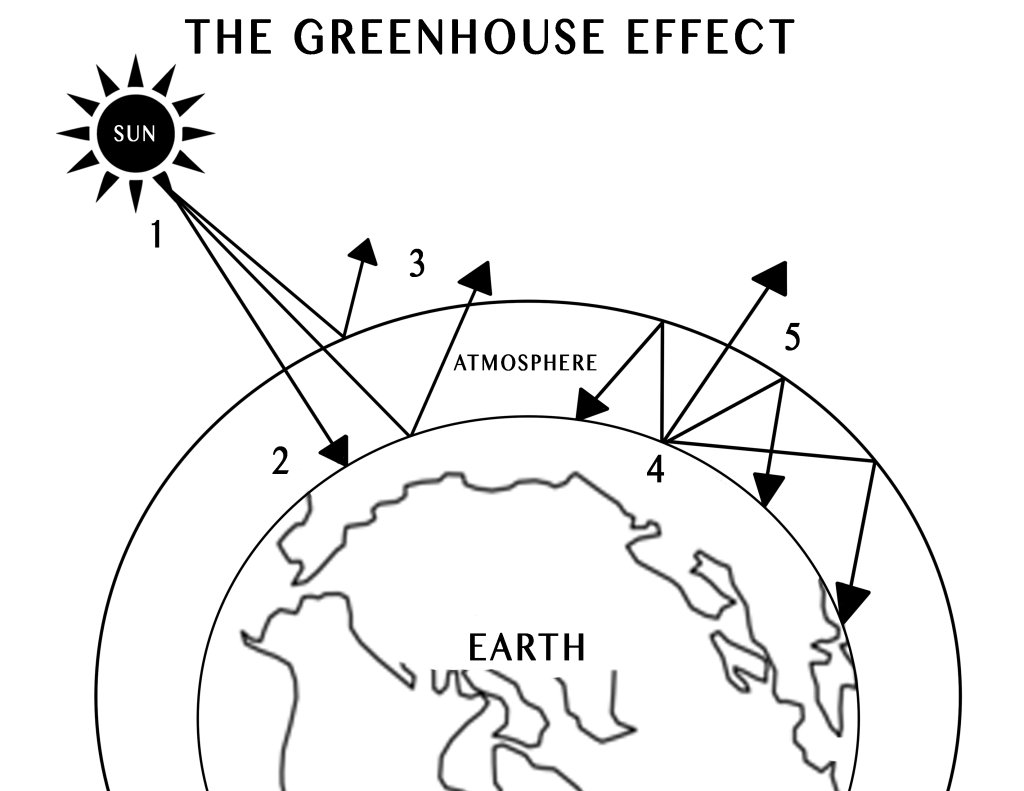
Enhanced Greenhouse Effects and their Relation to Global Warming
The phenomenon of the greenhouse effect is essential for maintaining Earth’s temperature within a habitable range. However, human activities have significantly increased the concentration of greenhouse gases, leading to enhanced greenhouse effect. The enhanced greenhouse effect is also known as “climate change or global warming”.
Factors Contributing to “Enhanced Greenhouse Effects”
- Deforestation to reduce and store CO2
- Production of CO2 from the burning of fossil fuels
- Release of CO2 from cement production.
- Release of nitrogen oxide from the use of high-nitrogen fertilizers
- Intensive production of livestock, which produces methane
Impacts of Enhanced Greenhouse Gases:
The enhanced greenhouse gases or climate change have negative impacts on potential consequences like rising sea levels, extreme weather events, melting of glaciers, and shifts in ecosystems.

Question No. 8
A- Write down note on Forensic Science and Criminology.
Question Breakdown:
In this question, the examiner has asked you to write notes on Forensic Medicine and Criminology. Deconstructing the terms, both are interconnected to one another, with Criminology being a wider field and forensic medicine a narrower. However, both are independently explainable too. Thus, start your answer by explaining Forensic Medicine with its definition, scope, and role. Then, explain the definition, scope, and role of Criminology. In the end, do not forget to explain the interrelationship between the both with similarities and differences in two to three lines or a schematic presentation.
Answer:
- (I) Forensic Medicine:
Definition of Forensic Medicine:
Forensic Medicine is a branch of science that deals with applying scientific methods and techniques for the investigation of crime or civil action and providing scientific evidence that could be used for legal proceedings.
Scope of Forensic Medicine:
Forensic Medicine is an applied natural science encompassing various scientific disciplines such as Biology, Chemistry, Physics, Genetics, and Information Technology. It, moreover, integrates medical knowledge with principles from Law, Criminology, Anthropology, and other fields to provide comprehensive insights into legal cases.
Application of Forensic Medicine:
Forensic Science plays a vital role in criminal investigations, providing crucial scientific support to aid in the pursuit of justice. Forensic scientists analyze physical evidence, such as DNA, fingerprints, fibres, and ballistics, to establish links between suspects, victims, and crime scenes. They employ advanced techniques and technologies to identify, interpret, and present evidence in a court of law.
- (II) Criminology
Define Criminology:
Criminology is the study of crime, its causes, and its consequences. Moreover, it deals with examining criminal behaviour, understanding the factors leading to crime, and developing theories to explain criminal activities.
Scope of Criminology:
Criminology is an interdisciplinary science that covers various fields and areas of study like Psychology, Biology, Sociology, Political Science, Law, Computer Science, Social Work, and Economics.
Application of Criminology:
In Criminology, criminologists analyze various aspects, including societal, psychological, and economic factors, to understand the root causes of crime. They study patterns, trends, and statistics to gain insights into crime rates and devise strategies for prevention and intervention. They also delve into the criminal justice system, exploring topics such as policy-making, law enforcement, corrections, and rehabilitation.
- (III) Relationship between Forensic Medicine and Criminology:

B- What are fertilizers? What do you understand by NPK Fertilizers?
Question Breakdown:
The question consists of two parts: What are fertilizers, and what are NPK fertilizers? Since NPK fertilizers come under a type of fertilizers, start your answer with the definition of Fertilizers and then explain their types highlighting NPK fertilizers. There is no need to explain each type separately; just drawing a flowchart of common categories with one or two examples of each is more than enough. Then, it directly moves towards explaining NPK fertilizers: their definition, examples, uses, and limitations. Remember, your GSA paper does not demand lengthy answers; thus, keeping into consideration the required length, try to inculcate the maximum of your knowledge in tables, charts, pie diagrams, etc., to make your paper stand out among thousand by managing the time and balancing the information and length simultaneously.
Answer:
- Fertilizers
Define Fertilizers:
Fertilizers are chemical substances that can be in a solid, liquid, or gaseous state and contain one or more plant nutrients and are supplied to the crops to increase their growth and yields. They supplement the natural nutrient content of the soil, ensuring that plants have an adequate supply of essential nutrients for healthy development.
Types and Examples of Fertilizers:

- NPK Fertilizers:
Define NPK Fertilizers:
NPK fertilizers, also known as compound fertilizers, are fertilizers that contain three primary nutrients, nitrogen (N), phosphorus (P), and potassium (K) in a balanced combination.
Composition of NPK Fertilizers:
The NPK ratio on fertilizer packaging represents the relative proportions of nitrogen, phosphorus, and potassium in the fertilizer formulation. For example, a fertilizer with an NPK ratio of 10-10-10 indicates that it contains 10% nitrogen, 10% phosphorus, and 10% potassium.
Global Consumption of NPK Fertilizers:
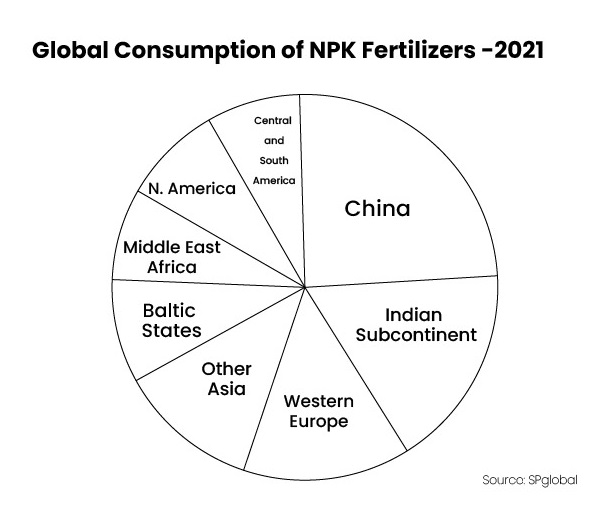
Advantages of NPK Fertilizers:
The three elements in NPK fertilizers have specific roles in supporting different aspects of plant growth:
- Nitrogen (N) helps with leaf and stem development, enhances chlorophyll production, and promotes overall plant growth.
- Phosphorus (P) supports root development, flowering, and fruiting, as well as plays a role in energy transfer and DNA synthesis.
- Potassium (K) contributes to overall plant health and helps with various physiological processes such as photosynthesis, enzyme activation, and water regulation
Nonetheless, different plants have varying nutrient requirements, so it is also an advantage of the NPK fertilizer that they can be formulated based on the type of crop and soil. Moreover, their compounded nature enables them to be less soluble in groundwater, making them suitable for dry soil matrices and areas prone to droughts.
Limitations of NPK Fertilizers:
While NPK fertilizers offer benefits by supplying essential nutrients to plants, they also have limitations and disadvantages, including potential nutrient imbalances, neglect of micronutrients, soil degradation, and environmental pollution. Moreover, overreliance can lead to soil dependency, altered pH, increased costs, and reduced nutritional quality.
Question No. 9
A- What is Anemia? What are its symptoms and causes?
Question Breakdown:
This question already consists of two parts, with the second part further divided into two. So, distribute your answer sagaciously. This question will be solved by giving 2:1:1 weightage to the asked parts. First, solve the first part by defining what anemia is, with diagnostic criteria and a diagram. Then move to the next part, explaining the symptoms and causes of anaemia with a pie-chart clarifying the distribution based on causes and symptoms. In the end, you can write the treatment mechanism in a sentence or two. Remember, draw as many relevant diagrams as you can in your GSA paper to obtain maximum marks.
Answer:
Define Anemia:
Anaemia is a medical condition characterized by a deficiency or destruction of red blood cells or a decrease in the amount of haemoglobin in the blood. In a broad sense, anaemia is the blood’s inability to supply adequate oxygen to the tissue for proper metabolism.
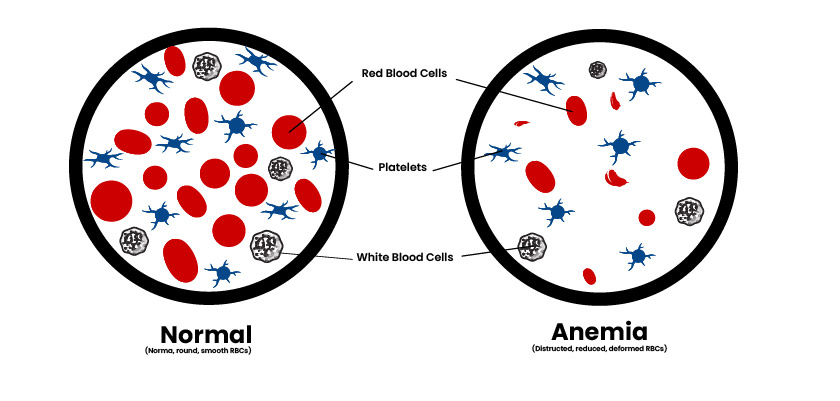
Diagnostic Criteria for Anemia:
The diagnostic criteria of Anemia are low hematocrit (Hct), low haemoglobin, or decreased Red Blood Cell (RBCs) count.
| Hematocrit | Male = <42%. Female = <37%. |
| Haemoglobin | Male = Hb <13.5 g/dL. Female = Hb 11.5 g/dL. |
| Red Blood Cells Count | Male = <4.7 million cells/mcL Female = < 4.2 million cells/mcL. |
Symptoms of Anemia:
- A feeling of unusual fatigue
- Reduced physical strength and stamina
- Pale Skin due to reduced oxygen supply
- Difficulty in breathing
- Dizziness or Lightheadedness
- Poor blood circulation leads to chilly extremities.
- Headache and Irregular Heartbeat
Causes and Risk Factors of Anemia:
Anaemia can have various underlying causes, which can be broadly categorized into three main groups
- Increased Blood Loss
- Gastro-Intestinal pathologies or bleeding
- Hemorrhoids
- Menorrhagia
- Hematuria
- Defective Red Blood Cell Formation
- Nutritional Inadequacies
- Pregnancy
- Excessive Red Blood Cells Destruction
- Genetic Variations
- Infections like Malaria
- Autoimmune Diseases
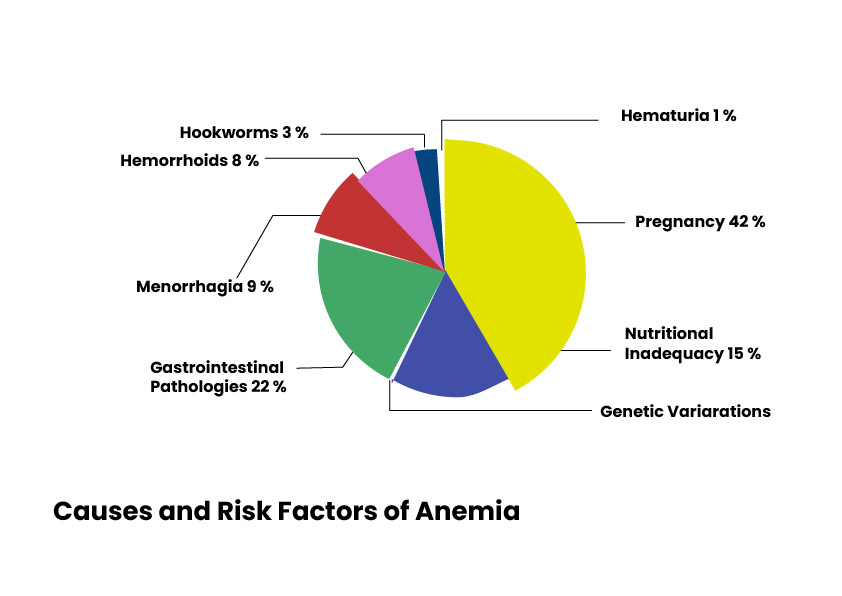
Ways to Reduce Anemia:
Treatment for anaemia depends on the underlying cause and severity of the condition. Some common treatment approaches include taking Iron or vitamin supplements, making dietary changes to include iron-rich foods, and treating underlying medical conditions or managing chronic diseases.
B- Write short note on space shuttle.
Question Breakdown
In this question, the examiner has asked you to write a note on Space Shuttle. Since the question demands “note”, write it at your ease. For instance, first, define the space shuttle, then its origin, then the components of the space shuttle, and the working mechanism. Selecting to write a working mechanism is a good approach in such a question because you can draw diagrams, making your GSA paper stand out among thousands of aspirants.
Answer:
Definition of Space Shuttle:
A space shuttle- officially called Space Transportation System- is a reusable spacecraft designed to transport people and cargo between Earth and space.
Origin of Space Shuttle:
The space shuttle was developed by the National Aeronautics and Space Administration (NASA), the United States space agency, as the fourth human spaceflight program in the 1970s. The goal was to create a spacecraft that could be reused multiple times, reducing the cost of space exploration and enabling more frequent missions.
Components of the Space Shuttle:
The space shuttle consisted of three main components:
- The orbiter, which was the wing spacecraft itself – NASA had five orbiters. Atlantis, Challenger, Columbia, Discovery and Endeavour)
- The solid rocket boosters (SRBs), which provide initial thrust during launch
- The external tank, which contains propellant for the main engines

Working Mechanism of Space Shuttle:
The Space Shuttle was a unique spacecraft with a combination of rocket-like launch and plane-like landing capabilities. Here are the main points describing its functioning:
- Launch and Ascent:
The Space Shuttle launched vertically like a rocket, propelled by three powerful engines fed by an enormous external fuel tank. Additionally, two solid rocket boosters attached to the tank provided extra thrust during liftoff. About two minutes into the flight, the solid rocket boosters burned out and separated. They parachuted into the Ocean for recovery and refurbishment. Once in space, the shuttle discarded the external fuel tank, which tumbled back into Earth’s atmosphere for destructive reentry.
- Orbital Operation:
In orbit, the shuttle used a series of small thrusters for manoeuvring. Two larger in-space engines were utilized for orbital changes and slowing down the shuttle during its return to Earth. The shuttle had a large cargo bay that could capture satellites for repair and act as a workspace for astronauts during servicing missions.
- Reentry and Landing:
After the mission, the shuttle reentered the atmosphere, shielded by heat-resistant tiles. The shuttle landed like a plane but had no engines during its return to Earth, making it a glider with only one chance to execute a successful landing on the runway.
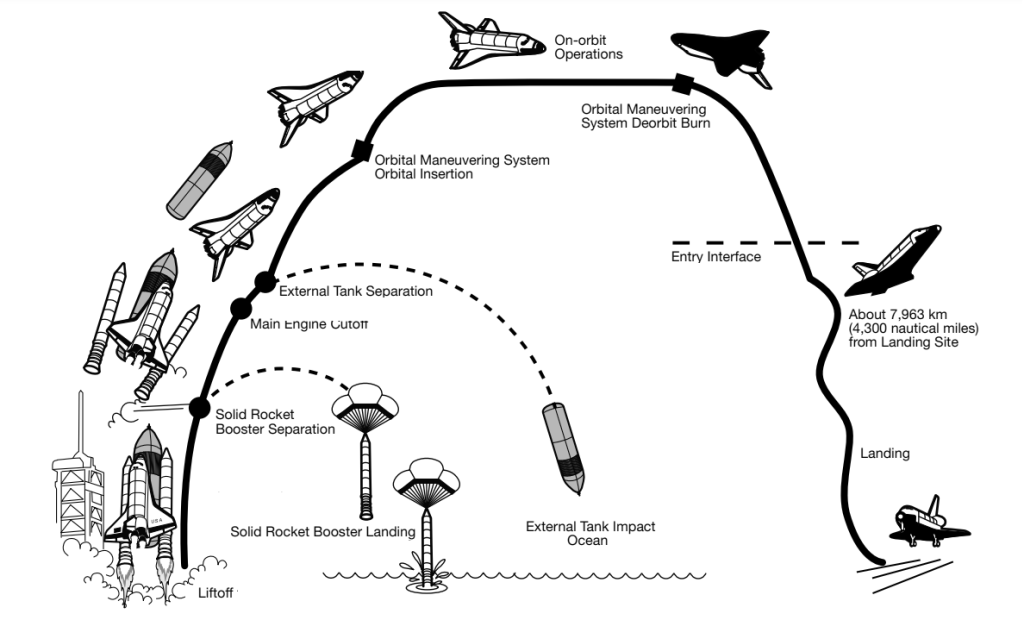
Retirement of space Shuttle:
The space shuttle program operated from 1981 to 2011, with a total of 135 missions. In 2011, NASA retired the space shuttle fleet, citing the need to focus on developing new spacecraft and technologies for future exploration beyond low-Earth orbit.
CSS Solved Past Papers’ Essays
Looking for the last ten years of CSS and PMS Solved Essays and want to know how Sir Kazim’s students write and score the highest marks in the essays’ papers? Then, click on the CSS Solved Essays to start reading them.
CSS Solved Essays

CSS Solved General Science & Ability Past Papers
| 1- | CSS Solved General Science And Ability Past Paper 2023 |
| 2- | CSS Solved General Science And Ability Past Paper 2022 |
| 3- | CSS Solved General Science And Ability Past Paper 2021 |
| 4- | CSS Solved General Science And Ability Past Paper 2020 |
| 5- | CSS Solved General Science And Ability Past Paper 2019 |
| 6- | CSS Solved General Science And Ability Past Paper 2018 |
| 7- | CSS Solved General Science And Ability Past Paper 2017 |
| 8- | CSS Solved General Science And Ability Past Paper 2016 |
| 9- | CSS Solved General Science And Ability Past Paper 2015 |
| 10- | CSS Solved General Science And Ability Past Paper 2014 |
| 11- | CSS Solved General Science And Ability Past Paper 2013 |
| 12- | CSS Solved General Science And Ability Past Paper 2012 |
| 13- | CSS Solved General Science And Ability Past Paper 2011 |
| 14- | CSS Solved General Science And Ability Past Paper 2010 |
| 15- | CSS Solved General Science And Ability Past Paper 2009 |
| 16 | CSS Solved General Science And Ability Past Paper 2008 |
| 17- | CSS Solved General Science And Ability Past Paper 2007 |
| 18- | CSS Solved General Science And Ability Past Paper 2006 |
| 19- | CSS Solved General Science And Ability Past Paper 2005 |
| 20- | CSS Solved General Science And Ability Past Paper 2004 |
| 21- | CSS Solved General Science And Ability Past Paper 2003 |
| 22- | CSS Solved General Science And Ability Past Paper 2002 |
| 23- | CSS Solved General Science And Ability Past Paper 2001 |
| 24- | CSS Solved General Science And Ability Past Paper 2000 |
Articles Might Interest You!
The following are some of the most important articles for CSS and PMS aspirants. Click on any to start reading.












